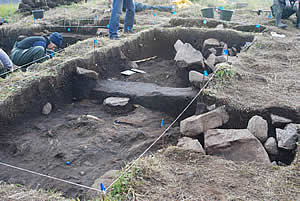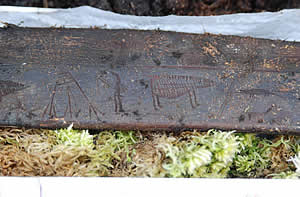Russian-American research team examines origins of whaling culture
Russian-American research team examines origins of whaling culture
Submitted by Kerynn Fisher
Phone: 907-474-6941
04/02/08

Download photo

Download photo
Recent findings by a Russian-American research team suggest that prehistoric cultures were hunting whales at least 3,000 years ago, 1,000 years earlier than was previously known.
University of Alaska Museum of the North archaeology curator Daniel Odess presented the team’s findings at the Society for American Archaeology annual meeting in Vancouver, British Columbia last week.
"The importance of whaling in arctic prehistory is clear. Prehistoric settlements were situated and defended so that people could hunt whales," says Odess. "Yet, as important as whaling is, we know very little about how, where and when it began."
The research focuses on the Un’en’en site near the modern whaling village of Nunligran on the Chukotka Peninsula. Researchers believe the site, discovered in 2005, was representative of the Old Whaling culture. The only other previously known Old Whaling culture site is on Cape Krusenstern, north of Kotzebue in northwestern Alaska.
Odess spent three weeks at the site last summer along with colleagues from Richard Stockton College (New Jersey), the University of Alaska Southeast, the Kunstkamera Museum in St. Petersburg and the Institute for Heritage in Moscow. The team also included several Chukotka residents; UAF graduate student Sarah Meitl and Tim Williams, a Fairbanks high school student and volunteer in Odess’ research lab.
"Before we arrived in Russia, I asked Tim what we might find that would tell us for certain whether people were whaling," says Odess. "As though it were the most obvious thing in the world, he said we should look for a picture."
They found that picture on one of the last days of the excavation: an ivory carving, approximately 50 cm long, with detailed carvings of animals and humans, including scenes of men in umiaks harpooning whales. The carving was found within or beneath the wooden roof of the structure the team excavated. Radiocarbon dating of wood samples in direct contact with the ivory carving confirm its age as 3,000 years old.
"The images on the carving combined with all the other evidence - a site ideally situated for hunting whales and walruses, the remains of those animals in the site, and the appropriate tools for hunting and butchering - all suggest that 3,000 years ago, people on the southern coast of the Chukotka Peninsula were hunting whales and walruses in much the same way that Eskimos were at the time of contact," says Odess. "It’s about as close to a smoking gun as you get in archaeology."
The 2007 field work was the first joint Russian-American archeological project in Chukotka and was supported by funding from the National Park Service and the National Science Foundation. Researchers continue to examine the artifacts, which are housed at the Institute for Heritage in Moscow.
CONTACT: Kerynn Fisher, University of Alaska Museum of the North communications coordinator, at 907-474-6941 or 907-378-2559.
Note to editors: Daniel Odess is on a leave of absence from the museum and can be reached at 202-354-2128 or via email at daniel.odess@gmail.com.


